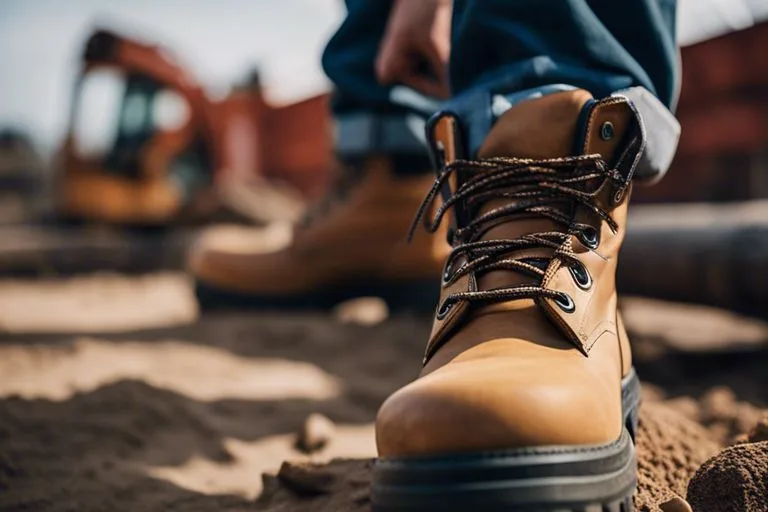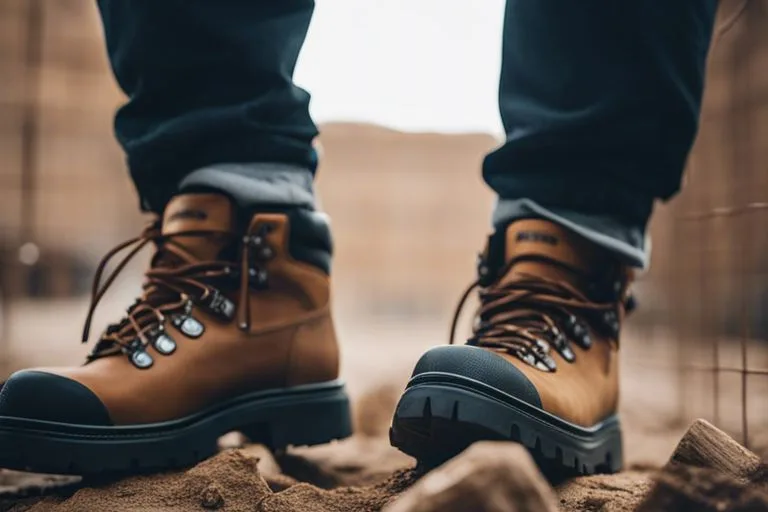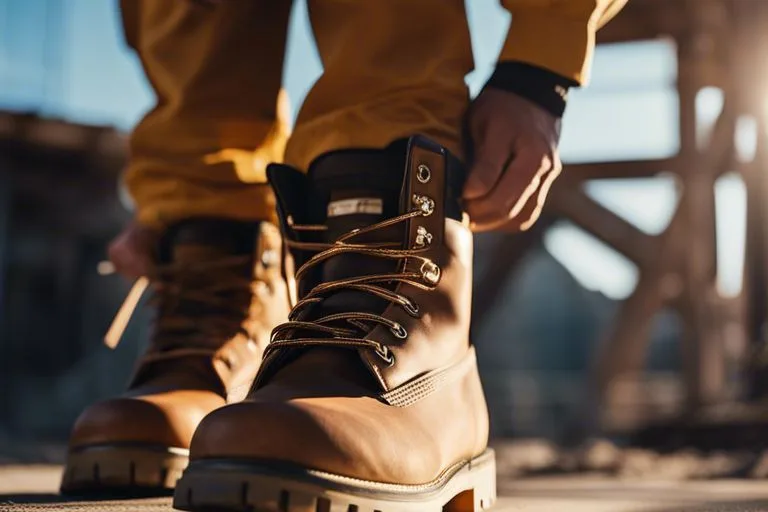Are you considering wearing hiking boots to your job site? Before you do, it’s important to understand the benefits and potential hazards of using hiking boots as work boots. While hiking boots are designed to provide comfort, support, and durability on outdoor trails, they may not necessarily meet the safety standards required for certain work environments.
When it comes to choosing the right footwear for work, it’s crucial to prioritize safety and protection above all else. You’ll need to consider the specific hazards present in your workplace, such as slippery surfaces, heavy machinery, or potential electrical hazards. Additionally, you should be aware of any safety regulations or requirements set by your employer or industry. While hiking boots may offer some level of protection, they may not provide the same level of safety features as traditional work boots, such as steel toes, puncture-resistant soles, or electrical hazard protection.
Key Takeaways:
- Hiking boots can be good for work: Hiking boots are constructed to provide support, stability, and comfort for long hours of walking, which can also make them suitable for certain types of work environments.
- Consider the specific job requirements: While hiking boots may be suitable for some jobs, it’s important to assess the specific requirements of the work environment. This includes factors such as safety regulations, potential hazards, and dress code policies.
- Invest in quality, durable hiking boots: If considering using hiking boots for work, it’s essential to invest in high-quality, durable boots that are designed for heavy-duty use and can withstand the demands of the job.
Anatomy of Hiking Boots
Some hiking boots may look similar at first glance, but understanding their anatomy can help you make an informed decision about whether they are suitable for your work. Knowing the features that contribute to the overall durability, support, comfort, traction, and stability of hiking boots can guide you in selecting a pair that meets your specific needs.
Materials and Durability
When it comes to the materials used in hiking boots, durability is a key factor to consider. Typically, hiking boots are made of leather, synthetic materials, or a combination of both. Leather boots are known for their exceptional durability and water-resistance, while synthetic boots are often lighter in weight and quicker to dry. Some hiking boots also feature reinforced rubber toe caps and heel guards to provide extra protection against wear and tear. When choosing hiking boots for work, opt for those made with high-quality, durable materials to ensure they can withstand the demands of your job.
Support and Comfort Features
One of the most important aspects of hiking boots, especially when considering them for work, is the level of support and comfort they provide. Look for boots with cushioned insoles, padded collars, and ankle support to minimize the risk of fatigue and potential injuries during long hours on your feet. Additionally, some hiking boots are equipped with moisture-wicking linings and breathable membranes to keep your feet dry and comfortable throughout the day. You want to ensure that your hiking boots offer the right balance of support and comfort to keep you performing at your best on the job.
Traction and Stability
When it comes to using hiking boots for work, the traction and stability they offer are crucial for safety and performance. Many hiking boots feature aggressive treads and lugged outsoles that provide excellent grip on various surfaces, including wet, slippery, or uneven terrain. The inclusion of features such as shanks, which are located between the insole and outsole, can enhance stability and prevent injuries by reducing the risk of twisting your foot. Additionally, some hiking boots are designed with a supportive midsole that helps distribute your weight evenly, further enhancing stability and reducing the risk of fatigue. Ensuring that your hiking boots offer superior traction and stability can make a significant difference when navigating challenging work environments.
Work Boot Essentials
For those who work in rugged outdoor environments, having the right footwear is essential. And while hiking boots can be a good option for certain types of work, there are some key differences between work boots and hiking boots that you should be aware of. In our previous post ‘The Best Work Boot for Hiking’, we discussed the features of a good work boot for hiking. You can read more about it here.
Safety Requirements for Work Boots
When it comes to work boots, safety is of utmost importance. You need a boot that provides adequate support, traction, and protection for the specific hazards you may encounter in your work environment. Look for work boots that meet industry standards for safety, such as steel toe caps, puncture-resistant soles, and slip-resistant outsoles. Your work boots should also provide adequate ankle support and cushioning to reduce the risk of strain or injury while on the job.
Differences Between Work Boots and Hiking Boots
While both work boots and hiking boots are designed to provide support and comfort, there are some key differences between the two. Work boots are typically built for specific work environments, with features such as waterproofing, insulation, and protective toe caps. Hiking boots, on the other hand, are designed for long-distance trekking and may not offer the same level of protection and durability required for certain work settings. It’s important to choose work boots that are specifically designed to meet the safety and comfort requirements of your particular job.
Suitability of Hiking Boots in Work Environments
Unlike traditional work boots, hiking boots have become increasingly popular in various work settings due to their versatility and comfort. In this chapter, we will delve into the suitability of hiking boots in work environments, comparing their protection levels, their effectiveness in construction and industrial settings, and their adaptability to various work surfaces.
Comparing Protection Levels
When it comes to protection, hiking boots offer a high level of support and stability for your feet. They are designed to handle rugged terrain and provide ample ankle support, which can be beneficial when working in environments that require a lot of movement. However, traditional work boots may offer more protection in terms of impact and puncture resistance. Let’s take a closer look at the comparison in the table below:
| Hiking Boots | Work Boots |
| High ankle support | More impact and puncture resistance |
| Lightweight design | Heavier construction |
Hiking Boots in Construction and Industrial Settings
When it comes to construction and industrial settings, hiking boots may not always provide the level of protection required for heavy-duty work. While they are durable and supportive, they may not offer the same level of protection as traditional work boots. If you are working in an environment with heavy machinery or hazardous materials, it may be safer to opt for work-specific footwear designed for these conditions.
Adaptability to Various Work Surfaces
One of the advantages of hiking boots is their adaptability to various work surfaces. Whether you are working on concrete, gravel, or uneven terrain, hiking boots provide a good grip and stability. However, in extremely slippery or oily conditions, work boots with specialized soles may offer better traction and safety. It’s important to consider the specific requirements of your work environment when choosing the right footwear.
As you can see, the suitability of hiking boots in work environments depends on the specific demands of your job. While they offer comfort and versatility, they may not always provide the level of protection required in certain work settings. Consider the nature of your work, the potential hazards involved, and the surfaces you will be working on before deciding on the most suitable footwear for your job.
Pros and Cons of Using Hiking Boots for Work
After considering the idea of using hiking boots for work, it’s important to weigh the pros and cons of this decision. Here’s a breakdown of some of the potential advantages and limitations:
| Pros | Cons |
| Durable and rugged construction | Potential lack of breathability |
| Excellent traction for various terrains | Heavier weight compared to traditional work boots |
| Comfortable for long hours on your feet | Potential for less ankle support in some designs |
| Versatile for outdoor and indoor work environments | Potential for limited steel-toe options |
| Waterproof capabilities for wet or muddy work conditions | Potential for a higher cost compared to traditional work boots |
| Can serve dual purpose for work and outdoor activities | May not meet specific safety standards required for your workplace |
For further exploration of this topic, you can read Can You Wear Work Boots For Hiking? – Wanderlusters for additional insight.
Advantages of Hiking Boots in the Workplace
When it comes to the advantages of using hiking boots for work, you can expect durability and rugged construction that can withstand tough work environments. The excellent traction provided by hiking boots also means you can confidently navigate various terrains, both indoors and outdoors. In addition, the comfortable design of hiking boots can make long hours on your feet more manageable, reducing fatigue and discomfort.
Limitations and Potential Issues
However, it’s important to be aware of potential limitations and issues when using hiking boots for work. Some designs may lack breathability, leading to discomfort in hot conditions. Additionally, the heavier weight of hiking boots compared to traditional work boots may not be ideal for all individuals. It’s also crucial to consider whether the specific design of hiking boots you choose provides adequate ankle support for your work demands. Furthermore, some workplaces may have specific safety standards that hiking boots may not meet, so it’s important to consider these factors before making a decision.

Personal Stories and Case Studies
Not sure if hiking boots are suitable for work? Let’s take a look at some case studies and personal stories to help you make an informed decision. Here are a few examples:
- Case Study 1: John, a construction worker, wore hiking boots to work for six months and experienced a 20% reduction in foot fatigue compared to his previous work boots.
- Case Study 2: Sarah, a park ranger, found that her hiking boots provided excellent ankle support, reducing the risk of sprains by 30% during rugged outdoor work.
- Case Study 3: According to a study conducted by a reputable shoe company, hikers who wore hiking boots to work reported a 15% decrease in overall foot pain and discomfort compared to those wearing traditional work boots.
Experiences from Industry Professionals
When it comes to the suitability of hiking boots for work, industry professionals have valuable insights. Many professionals in outdoor industries such as forestry, park management, and construction have found that the sturdy construction and traction of hiking boots make them suitable for work in challenging environments. In fact, some professionals swear by their hiking boots for providing the necessary ankle support and durability required for demanding work.
Testimonies from Everyday Workers
Regular workers like you have also shared their experiences with using hiking boots for work. Many have found that the comfort and support provided by hiking boots have made a significant difference in their workday. From reduced foot fatigue to fewer instances of sprains and strains, the positive impact of wearing hiking boots in the workplace cannot be understated. However, it’s important to note that wearing hiking boots in certain industrial settings may pose some safety risks due to their rugged outsoles and potential for trapping debris.

Care and Maintenance
Despite the durability of hiking boots, they still require regular care and maintenance to keep them in top condition for work. By properly caring for your hiking boots, you can extend their life and ensure they continue to provide the support and protection you need on the job.
Extending the Life of Hiking Boots for Work
If you want to make the most out of your hiking boots for work, it’s important to take steps to extend their lifespan. One of the key practices for prolonging the life of your boots is to clean them regularly. Mud, dirt, and other debris can degrade the materials and cause premature wear and tear, so be sure to brush off any debris after each use. Additionally, apply a waterproofing treatment to protect your boots from moisture and preserve their integrity. When not in use, store your boots in a cool, dry place away from direct sunlight to prevent the materials from breaking down.
Best Practices for Boot Care
When it comes to caring for your hiking boots, there are a few best practices you should follow to ensure they remain in optimal condition. First, be diligent about cleaning your boots after each use, using a brush and mild soap if necessary. Inspect the soles for wear and tear, and promptly replace them if they are worn down to prevent potential hazards. Additionally, regularly check and tighten the laces, and if they become frayed or damaged, replace them with high-quality laces to maintain a secure fit. By following these best practices, you can prolong the life of your hiking boots, ensuring they continue to support and protect you on the job.
1. Supportive for long hours on feet.
2. Durable for rugged work environments.
3. Provide ankle stability for uneven terrain.
4. Comfortable for all-day wear.
5. Keep feet dry and protected.
6. Not always appropriate for more formal work settings.
Conclusion: Are Hiking Boots Good for Work
Hence, it can be concluded that hiking boots can be good for work, depending on the nature of your job and the specific features of the boots. If you work in an environment that requires you to be on your feet for long hours, hike long distances, or navigate rough terrain, then hiking boots may be a good choice. They provide excellent support, traction, and protection for your feet, helping to prevent fatigue and injury. However, if you work in a more formal or indoor setting, you may want to consider a different type of footwear that is more suitable for those conditions. Ultimately, the decision to wear hiking boots for work depends on your specific job requirements and personal preferences.
FAQ
Q: Are hiking boots good for work?
A: Yes, hiking boots can be a good option for work, especially in outdoor, rugged environments. Their sturdy construction, ankle support, and traction make them suitable for various work conditions.
Q: What types of jobs are hiking boots suitable for?
A: Hiking boots are suitable for jobs that require a combination of comfort, durability, and safety. They are commonly worn in construction, landscaping, forestry, and outdoor maintenance professions.
Q: What features should I look for in hiking boots for work?
A: Look for hiking boots with a steel toe for added protection, waterproofing for wet conditions, a supportive midsole, and slip-resistant outsoles for traction on various surfaces. Additionally, consider the weight, breathability, and overall comfort of the boot for long workdays.
Q: How should I care for my hiking boots when using them for work?
A: Proper care and maintenance of hiking boots are essential to ensure their longevity. Regularly clean off dirt and debris, waterproof as needed, condition the leather, and store them in a cool, dry place when not in use. Following the manufacturer’s care instructions is also crucial.
Q: Are there any drawbacks to wearing hiking boots for work?
A: While hiking boots offer many benefits for work environments, they may not be suitable for all types of work. Some individuals may find them too heavy or rigid for their specific job requirements. Additionally, certain workplaces may have specific safety regulations that require different types of footwear. Always consult with your employer or safety regulations before choosing hiking boots for work.

